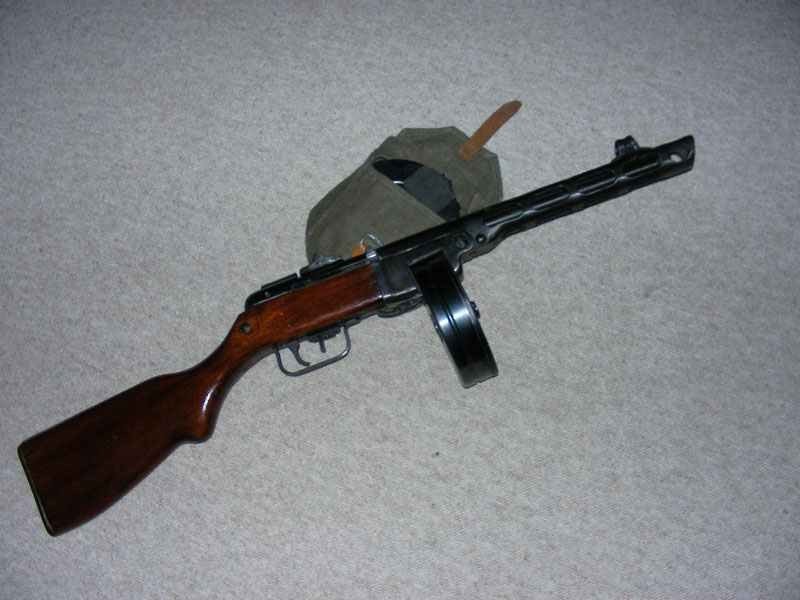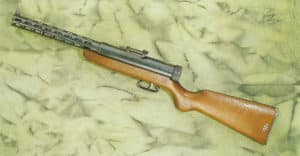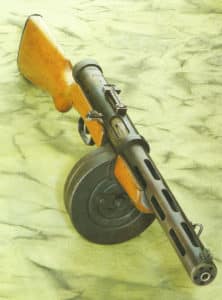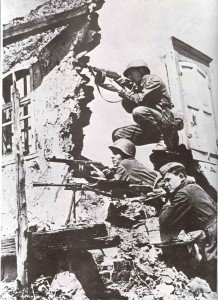Russian sub-machine gun PPSh-1941G of the Red Army in WW2.
History, development, service, specifications, pictures and 3D model.

PPsH sub-machine gun
Table of Contents
PPSh-1941G
Type: Sub-machine gun.
The PPSh-41 (Pistolet-Pulemyot Shpagina, or Shpagin’s Machine Pistol) was a Soviet submachine gun designed by Georgy Shpagin. It was extensively used during World War II and became one of the most recognizable weapons of the Soviet Army.
Overview
Design and Production:
– Introduced in 1941 as a replacement for the more complex PPD-40
– Simple design allowed for mass production
– Over 6 million units produced during World War II
Technical Specifications:
– Caliber: 7.62×25mm Tokarev
– Weight: 3.63 kg (8 lbs)
– Length: 843 mm (33.2 in)
– Barrel length: 269 mm (10.6 in)
– Rate of fire: 900 rounds per minute
– Effective range: 150-200 meters
Features:
– Blowback-operated, selective fire (full-auto and semi-auto)
– Distinctive drum magazine holding 71 rounds (later models used 35-round box magazines)
– Compensator on the muzzle to reduce muzzle climb during automatic fire
Performance:
– High rate of fire made it effective in close-quarters combat
– Reliable in harsh conditions, including extreme cold
– Relatively accurate for a submachine gun of its era
Historical Significance:
– Widely used by Soviet forces on the Eastern Front
– Captured examples were prized by German soldiers
– Used by various communist and Soviet-allied forces after WWII
Variants and Derivatives:
– Type 50 (Chinese copy)
– K-50M (North Vietnamese modification)
– PPS-43 (simplified version for easier production)
The PPSh-41 played a crucial role in Soviet infantry tactics during World War II and remained in service with various armed forces well into the Cold War era.
History

The Russians collected their first experiences with sub-machine guns during the Spanish Civil War.
Since the mid-twenties of the last century, various designs of sub-machine guns have been tested in Russia. The first Russian sub-machine gun was then introduced to the Red Army in 1935, which was developed by Degtyarev and was designated PPD.
It was successfully used by ‘volunteers’ of the communist forces in Spain, and so mass production was decided in Moscow. The first model was designated as PPD-34/38 and several thousand copies were produced therefrom.
After the appearance of the Finnish Suomi sub-machine gun, the PPD-40 gun was reworked, which resulted in an improved magazine construction with a large drum magazine. Here the 71-shot drum magazine began to appear, which should become so unpleasant for the German soldiers in the Russian campaign.
The mechanism was made by simple rebound and the weapon is easily recognizable by its wooden shaft and the perforated cooling jacket around the barrel.

The production of the PPD-40 began as early as March 1940. However, the PPD-40 was not easy to manufacture since it was made of hand-made steel and inside the barrel of chrome. Thus, in 1940 only 81,118 pieces were built and in 1941 another 5,868 pieces were built. The production ended for the simple reason that the weapons factories in which the PPD-34/38 and PPD-40 were built were quickly overrun by the German troops, and the extensive machines needed for their manufacture were not found anywhere else.
The majority of these machine guns were lost during the first months of Operation Barbarossa, but single specimens of these well-processed weapons were in use throughout the war.

The Pistolet Pulyemet Shpagin PPSh was developed in 1940 as a replacement for the PPD40 model, since although the PPD was good it was not entirely suited to fast production in huge quantities.
The first PPSh-41 were issued to the Red Army on December 21, 1940. However, it was only under the pressure of the German invasion that the weapon was issued from 1942 onward to Russian units in quantities.
Even though the PPD was good, it was not suitable for being produced quickly in huge quantities by unskilled laborers in primitive weapons factories. However, this was the most important Russian concern in 1941-42.

Specifications for PPSh-1941G
Specifications:
PPSh-1941G | specification |
|---|---|
Type | sub-machine gun |
Caliber | 7.62mm |
Length | 33.10 in |
Weight | 8 lb |
Barrel | 10.5 in long, 4 grooves, right hand twist |
Feed system | 71-round detachable drum or 35-round detachable box |
System of operation | Blowback, selective fire |
Muzzle velocity | 1,650 feet/sec |
Rate of fire | 900 rpm |
Service statistics:
PPSh-1941G | figures |
|---|---|
Manufactures | Soviet State Arsenals |
Production delivery | December 21, 1940 |
Final delivery | after 1945 |
Production 1942 | c.1.5 millions |
Production figure | c.5 millions (of which 10,000 from 1943 in Tehran, Iran) |

References and literature
The Encyclopedia of Infantry Weapons of World War II (Ian V.Hogg)
Infanterie im 2. Weltkrieg (J.B.King, John Batchelor)
Illustriertes Lexikon der Waffen im 1. und 2. Weltkrieg (V. Dolinek, V. Francev, J. Sach)
The Encyclopedia of Weapons of World War II (Chris Bishop)








